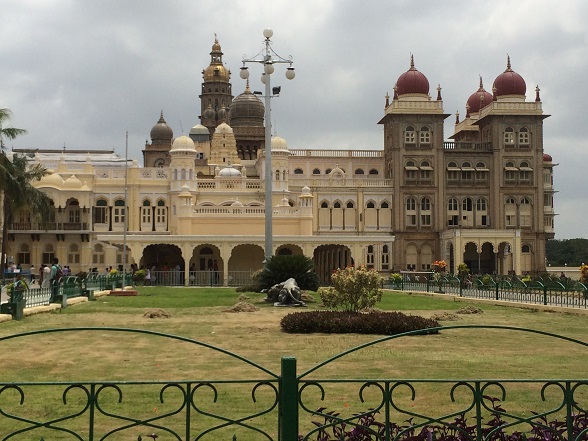
The Palace of Mysore, also known as the Amba Vilas Palace, is a historical palace situated in the city of Mysore. It is the official residence and seat of the Wodeyars – the Maharajas of Mysore, the former royal family of Mysore, which ruled the princely state of Mysore from 1399 to 1950.
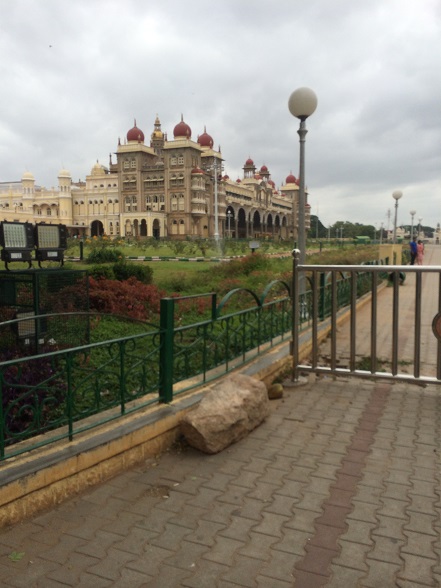
The palace also houses two durbar halls (ceremonial meeting halls of the royal court) and incorporates a mesmerizing and gigantic array of courtyards, gardens, and buildings. The palace is located in the middle of town, facing the Chamundi Hills eastward. Mysore is commonly described as the City of Palaces, for there are about seven palaces in the area, however, the Mysore Palace refers specifically to the one within the Old Fort. King Yaduraya first built a palace inside the Old Fort in Mysore in the 14th century, which was demolished and constructed multiple times.
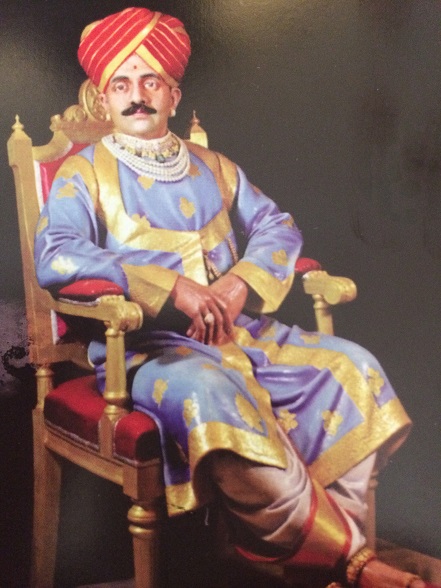
The regent of Mysore, Her Royal Majesty Maharani Vani Vilas Sannidhna, and her son, the Maharaja of Mysore His Highness Rajarshi Sri Sir Krishnaraja Wodeyar IV (pictured), commissioned the British architect Lord Henry Irwin to build a new palace to replace the old one which had burnt down due to a lightning strike. Construction of the current palace was commissioned in 1897, completed in 1912, and expanded around 1940 (including the addition of the present Public Durbar Hall wing) during the reign of His Highness Maharaja Sri Sir Jayachamarajendra Wadiyar, the last Maharaja of Mysore Kingdom. The construction was completed in 1912, but the fort continued to be beautified and its inhabitants were slowly moved to the newer extension built off the palace.
Again we see the architectural style, Indo-Saracenic, which blends Hindu, Muslim, Rajput, and Gothic styles of architecture. It is a three-stone structure with marble domes and a 145 ft. five-story tower. The palace is surrounded by a large garden. The entrance gate and arch hold the emblem and coat of arms of the kingdom of Mysore, around which is written the kingdom’s motto in Sanskrit: “न बिभॆति कदाचन” (never terrified).
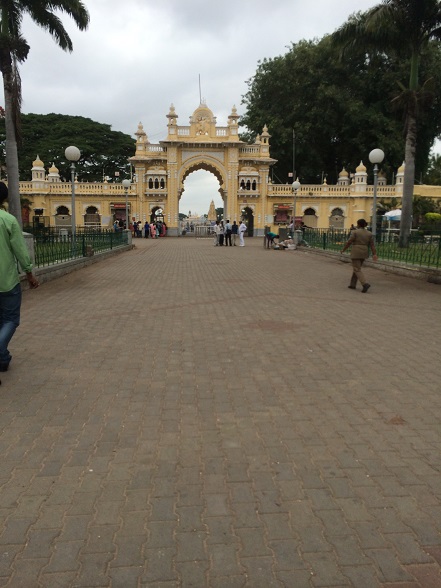
The palace has three entrances: the East Gate which is considered the front gate, opened only during the Dasara, (a major celebration here) for VVIPs, the South Entrance (for the public), and the West Entrance (usually opened only during the Dasara). The above picture is the gate that we were allowed to enter, the South Entrance. The picture below was fun. As excited as I was to see the Palace, so was this cow.
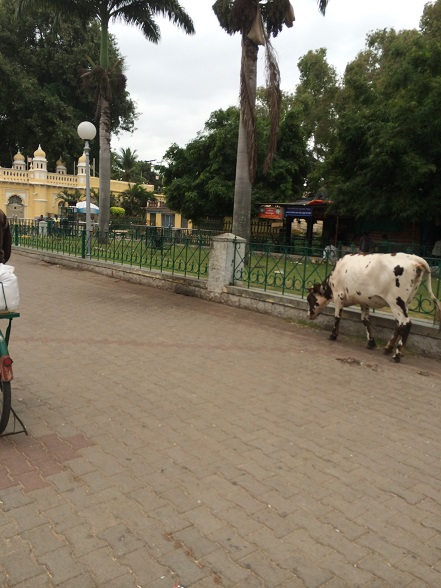
You may think I was only kidding, but the picture below proves I am right. LOL
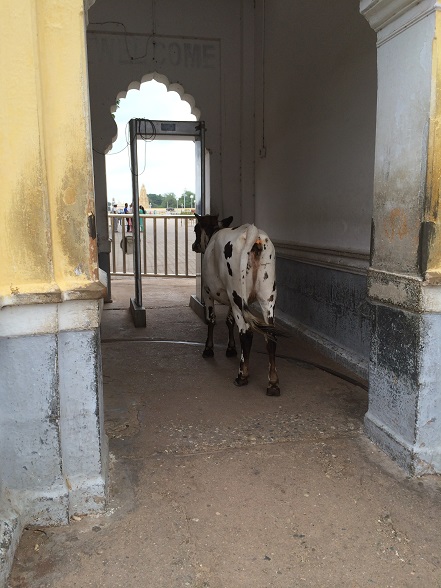
In addition, there are numerous secret tunnels from the palace cellar leading to Srirangapatna (a neighboring town), other palaces, and confidential areas.
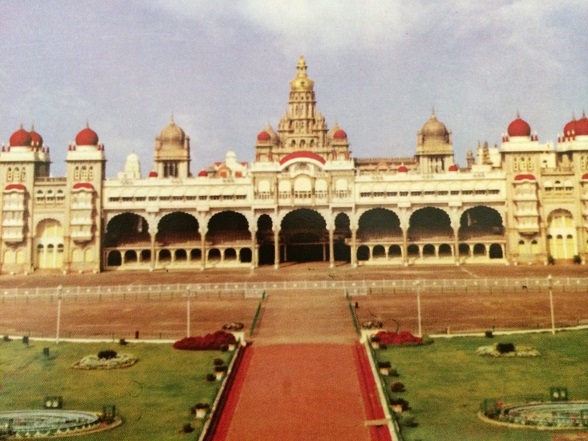
The three-story stone building of fine gray granite with deep pink marble domes has a facade with several expansive arches and two smaller ones flanking the central arch, which is supported by tall pillars. Above the central arch is a sculpture of Gajalakshmi, the goddess of wealth, prosperity, good luck and abundance with her elephants. There are three major exclusive temple buildings within the Old Fort, and about 18 inside the palace heart building. The Maharajas of Mysore were devotees of Goddess Chamundi, which is why the place faces Chamundi Hills.
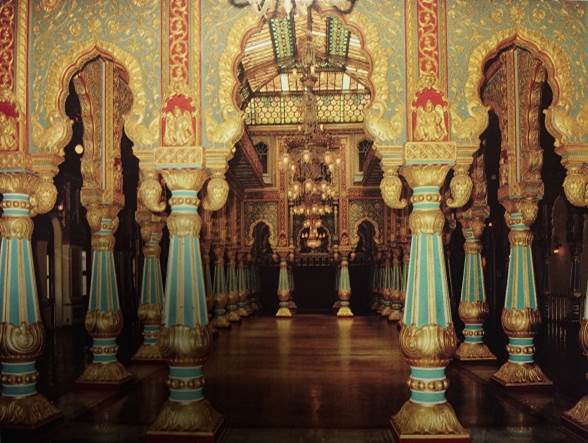
This room is called Ambavilasa and used by the king as a hall for private audiences. Entry to this opulent hall is through an elegantly carved rosewood doorway inlaid with ivory that opens into a shrine dedicated to Ganesha the elephant god. The central nave of the hall has ornately gilded columns, stained glass ceilings, decorative steel grills, and chandeliers with fine floral motifs, mirrored in the pietra dura (a process used to inlay) mosaic floor embellished with semi-precious stones.
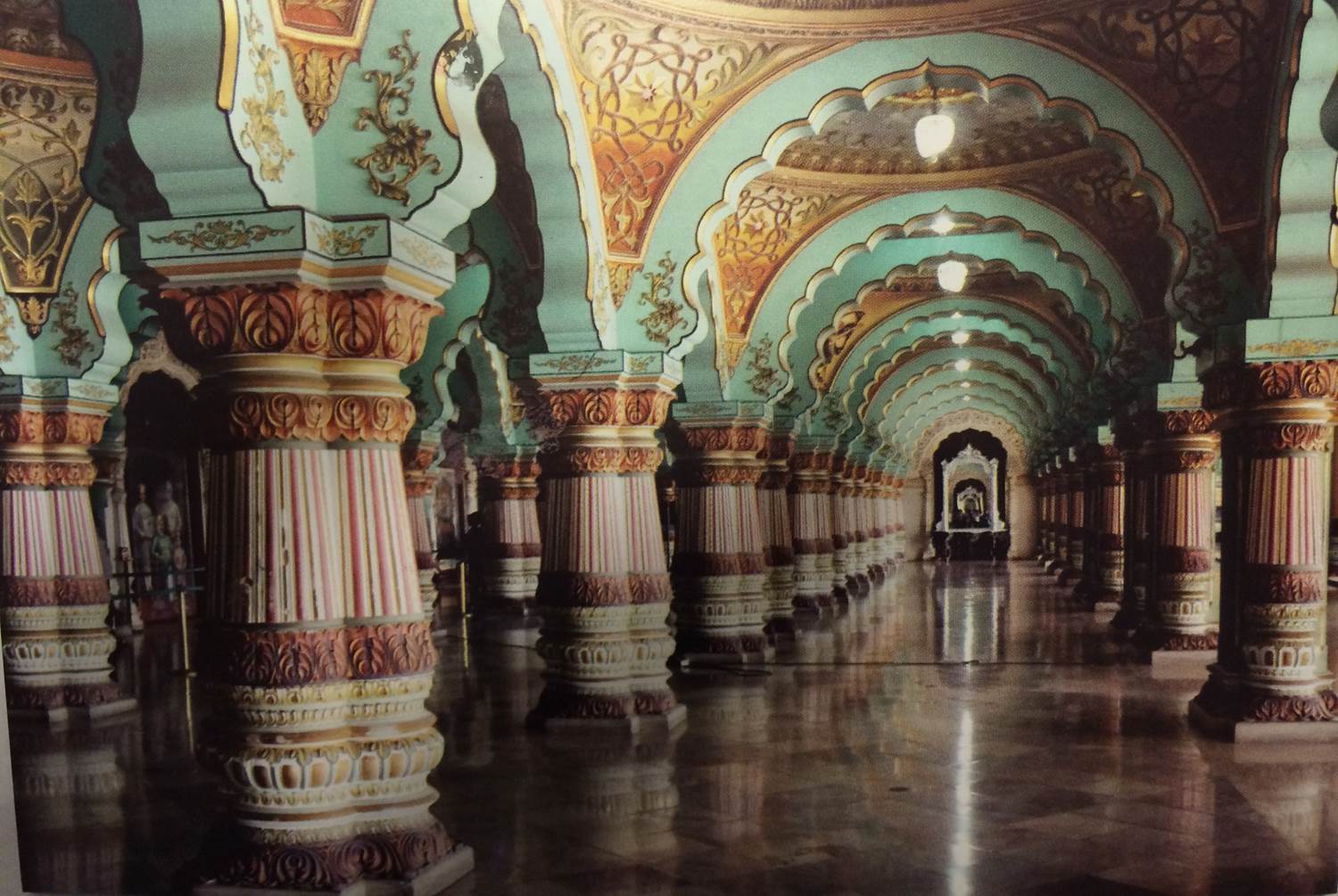
Dunbar Hall (picture above) was used for public gatherings. The pillars were magnificient. In each room they were a little different.
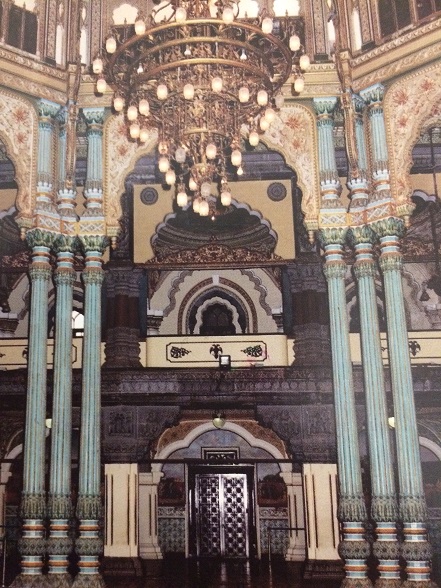
The Kalyana Mantapa, or marriage hall, is a grand, octagonal-shaped pavilion with a multi-hued stained glass ceiling with peacock motifs arranged in geometrical patterns. The entire structure was wrought in Glasgow, Scotland. The floor also displays a peacock mosaic, designed with tiles from England. Oil paintings illustrating the royal procession and Dasara celebrations of bygone years are displayed on the walls. The most magnificent thing about this room and really the entire palace was this set of silver doors. Beautiful beyond belief.
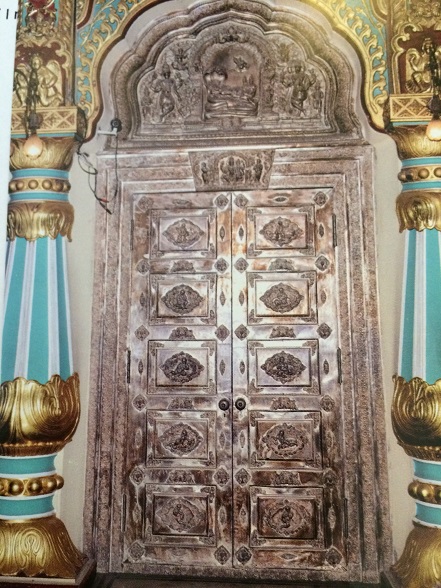
Every autumn, the Palace is the venue for the famous Mysore Dasara festival, during which leading artists perform on a stage set up in the palace grounds. On the tenth day of the festival Vijaya Dashami, a parade with caparisoned elephants and floats originate from the palace grounds. Below is a picture that was displayed in the marriage room of one such festival. The elephants for these festivals are kept on the grounds still today.
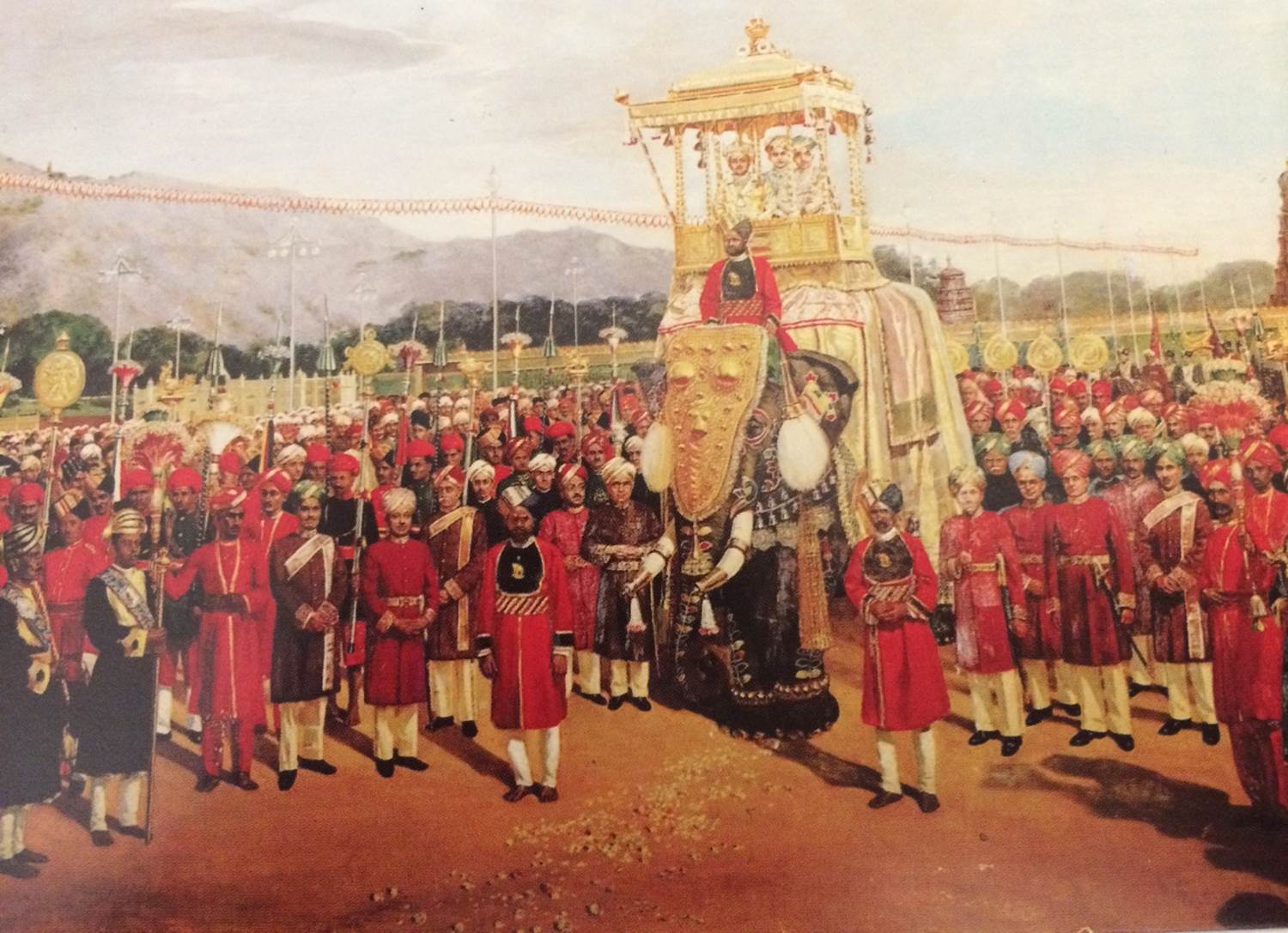
Dasara is the most extravagant festival of Mysore. The Dasara festival is celebrated in September and October of each year. The festival celebrates and commemorates the victory of the great Goddess Durga, also called Chamundeshwari, after she slew the demon Mahishasura, thereby symbolizing the triumph of good over evil according to Hindu mythology.
This festival has been celebrated by the Wodeyars at Srirangapatna since 1610, and in Mysore with great pomp since 1799. The tradition is still carried on, although the scale of the celebrations has diminished. During this festival, treasures that would normally be stored away are brought out for the public to see (they don’t keep that heavy of security around all year). One such extremely valuable piece is the golden throne of which I only saw a picture.
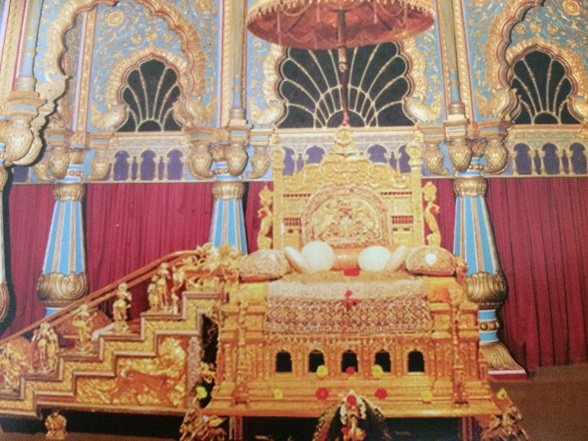
Narender says that there are rooms and rooms of these treasures which include silver cradles, ceremonial gowns and incredible jewelry. We even passed by the doors of one of the temples located inside the main palace in which only the “royals” are allowed.
So I said to him, “So you haven’t seen in there?”
He replied with intention, “No….not yet!” LOL
The Dasara festivities have become an integral part of the culture and life in Mysore.
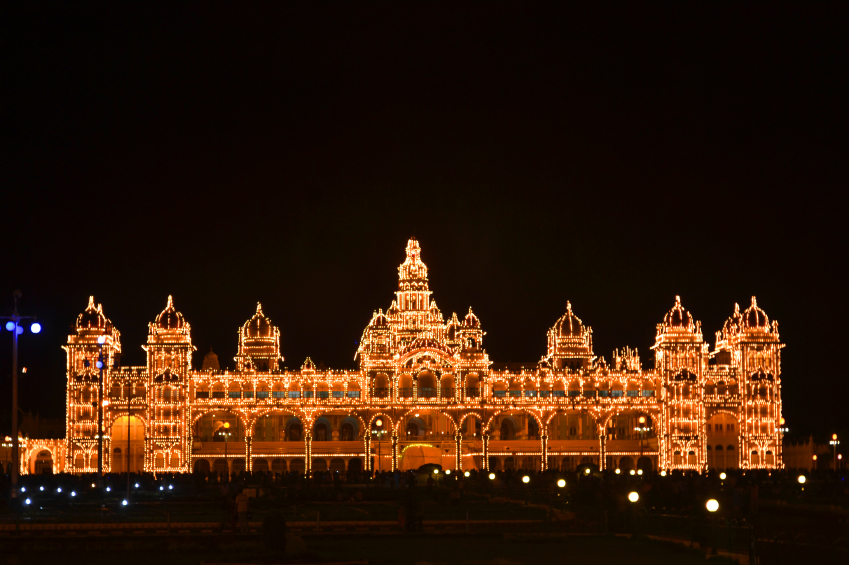
To celebrate this festival, the Palace of Mysore is illuminated with more than 96,000 lights during the two-month period. This is only a picture, but I would love to see this in person some day.
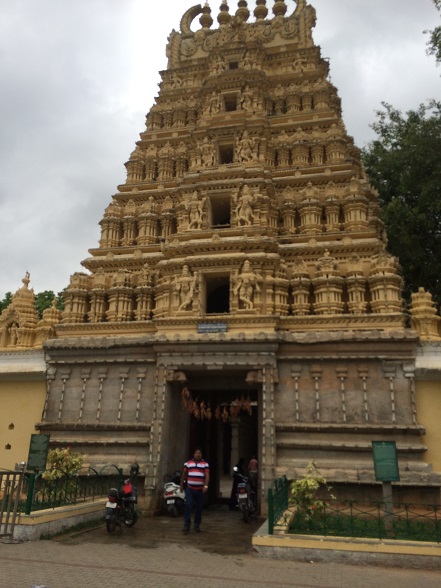
The palace complex includes twelve Hindu temples. The three most famous of these are the Someshvara Temple, dedicated to God Lord Shiva; Lakshmiramana Temple, dedicated to God Lord Vishnu; and Shwetha Varahaswamy Temple, dedicated to Lord Varahaswamy, one of the 10 incarnations of lord Vishnu.
Lakshmiramana temple (picture) is dedicated to Lord Vishnu (Lakshmiramana). The temple also has a separate shrine for Goddess Lakshmi. There is one more shrine for Venugopala – Lord Krishna. The temple was built by the King Narasa Nayaka of Vijayanagar in 1499 AD. This temple has witnessed an historical event, which was the coronation of 5-year-old Krishnaraja Wodyar III by the Britishers in 1799 after the death of Tipu Sultan.
The temple, even though small in size, is very beautiful and neat. There is a belief that the prayers at this temple are always answered.
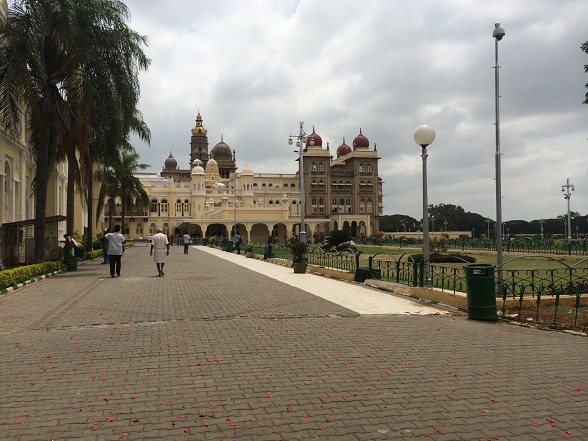
Upon leaving the palace grounds we walked around the far side of the building, and came upon elephant rides. Knowing I would be doing this tomorrow, I passed on a ride today.
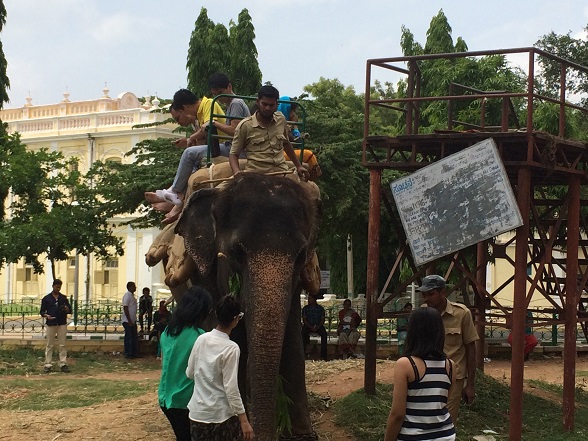
Back in the car we head for the hills…The Chamundi Hills
Stayed tuned for the next blog, thanks so much for reading. Please share with your friends.
